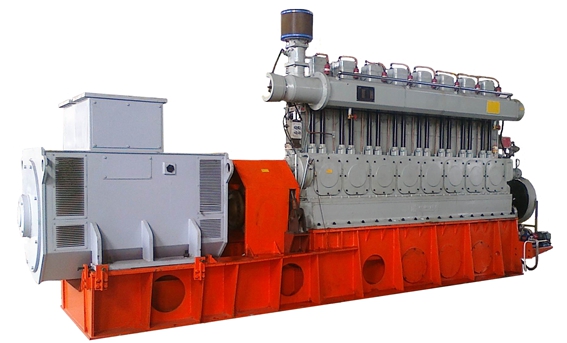沼氣的凈化一般應包括沼氣的脫水、脫硫及脫二氧化碳。沼氣中的水分與硫化氫共同作用, 能加速管道及閥門、流量計的腐蝕,硫化氫還對大氣造成污染,所以要脫除。
The purification of biogas generally includes the dehydration, desulfurization and CO2 removal of biogas. The moisture in biogas and hydrogen sulfide act together to accelerate the corrosion of pipelines, valves and flow meters. Hydrogen sulfide also pollutes the atmosphere, so it should be removed.
沼氣如何進行脫水:從發*裝置出來的沼氣含有飽和水蒸氣,可用3種方法將其去除。
How to dehydrate biogas: the biogas from the generator contains saturated water vapor, which can be removed by three methods.
(1)冷分離法。是利用壓力能變化引起溫度變化,使水蒸氣從氣相中冷凝下來的方法。常用 的有兩種流程:A.節流膨脹冷脫水法。一般用于高壓燃氣,經過節流膨脹或低溫分離,使 部分水冷凝下來。B.加壓后冷卻法。如凈化氣在08MPa壓力下的冷卻脫水。
(1) Cold separation method. It is a method of condensing water vapor from the gas phase by using the change of pressure energy to cause the change of temperature. There are two commonly used processes: A. throttling expansion cold dehydration method. It is generally used for high-pressure gas to condense some water after throttling expansion or low-temperature separation. B. Pressurized cooling method. For example, the purified gas is cooled and dehydrated under the pressure of 0.8MPa.
(2)溶劑吸收法。屬于這類脫水溶劑的有氯化鈣、氯化鋰及甘醇類。
(2) Solvent absorption method. Calcium chloride, lithium chloride and glycol belong to this kind of dehydration solvent.

(3)固體物理吸水法。吸附是在固體表面力作用下產生的,根據表面力的性質分為化學吸附( 脫水后不能再生)和物理吸附(脫水后可再生)。
(3) Solid physical water absorption method. Adsorption is produced under the action of solid surface force. According to the nature of surface force, it can be divided into chemical adsorption (which cannot be regenerated after dehydration) and physical adsorption (which can be regenerated after dehydration).
沼氣的脫硫:沼氣中的有害物質主要是硫化氫,它危害人體健康,對管道閥門及應用設備有較強的腐蝕作 用。目前,國內大部分用戶均未安裝脫硫器,已造成嚴重后果。為減輕硫化氫對灶具及配套 用具的腐蝕損害,延長設備使用壽命,保證人身健康,需要安裝脫硫器。脫硫原理:在常溫下含有H2S的沼氣通過脫硫劑床層,沼氣中H2S與活性物質(如氧化鐵)接觸,生成 硫化鐵和亞硫化鐵,然后含有硫化物的脫硫劑與空氣中的氧接觸,當有水存在時,鐵的硫化 物又轉化為氧化鐵和單體硫。這種脫硫和再生過程可循環進行多次,直至氧化鐵脫硫劑表面 大部分被硫或其他雜質覆蓋而失去活性為止。脫硫方法:脫硫的方法有濕法脫硫和干法脫硫兩種。干法脫硫具有工藝簡單,成熟可靠、造價低等優點 ,并能達到較好的交貨程度。目前家用沼氣脫硫基本上采用這種方法。干法脫硫劑有活性炭、氧化鋅、氧化錳及氧化鐵等,從運轉時間、使用溫度、公害、價格等 綜合考慮,目前采用比較多的脫硫劑是氧化鐵。
Desulfurization of biogas: the harmful substance in biogas is mainly hydrogen sulfide, which is harmful to human health and has a strong corrosive effect on pipeline valves and application equipment. At present, most domestic users have not installed desulfurizer, which has caused serious consequences. In order to reduce the corrosion damage of hydrogen sulfide to cookers and supporting appliances, prolong the service life of equipment and ensure personal health, desulfurizer needs to be installed. Desulfurization principle: under normal temperature, the biogas containing H 2S passes through the desulfurizer bed. The H 2S in the biogas contacts with active substances (such as iron oxide) to form iron sulfide and iron sulfide, and then the desulfurizer containing sulfide contacts with oxygen in the air. When there is water, the iron sulfide is transformed into iron oxide and monomer sulfur. This desulfurization and regeneration process can be recycled for many times until most of the surface of iron oxide desulfurizer is covered by sulfur or other impurities and becomes inactive. Desulfurization methods: there are two desulfurization methods: wet desulfurization and dry desulfurization. Dry desulfurization has the advantages of simple process, mature and reliable, low cost and good delivery. At present, domestic biogas desulfurization basically adopts this method. Dry desulfurizing agents include activated carbon, zinc oxide, manganese oxide and iron oxide. Considering the operation time, service temperature, public hazards and price, iron oxide is the most widely used desulfurizing agent at present.
The wonderful contents of this article are provided by biogas purification knowledge. There are many wonderful contents on this website. You can click to enter more contents: http://www.fcw-app.com We have special customer service to answer your questions
